The Caucasian War (Russian: Кавказская война, romanized: Kavkazskaya voyna) or Caucasus War was a 19th-century military conflict between the Russian Empire and various peoples of the North Caucasus who resisted subjugation during the Russian conquest of the Caucasus. It consisted of a series of military actions waged by the Russian Imperial Army and Cossack settlers against the native inhabitants such as the Adyghe, Abaza–Abkhaz, Ubykhs, Chechens, and Dagestanis as the Tsars sought to expand.[7]
Russian control of the Georgian Military Road in the center divided the Caucasian War into the Russo-Circassian War in the west and the conquest of Chechnya and Dagestan in the east. Other territories of the Caucasus (comprising contemporary eastern Georgia, southern Dagestan, Armenia and Azerbaijan) were incorporated into the Russian Empire at various times in the 19th century as a result of Russian wars with Persia.[8] The remaining part, western Georgia, was taken by the Russians from the Ottomans during the same period.
History
The war took place during the administrations of three successive Russian Tsars: Alexander I (reigned 1801–1825), Nicholas I (1825–1855), and Alexander II (1855–1881). The leading Russian commanders included Aleksey Petrovich Yermolov in 1816–1827, Mikhail Semyonovich Vorontsov in 1844–1853, and Aleksandr Baryatinskiy in 1853–1856. The famous Russian writer Leo Tolstoy, who gained much of his knowledge and experience of war for his book War and Peace from these encounters, took part in the hostilities. The Russian poet Alexander Pushkin referred to the war in his Byronic poem "The Prisoner of the Caucasus" (Кавказский пленник, Kavkazskiy plennik), written in 1821. Mikhail Lermontov, often referred to as "the poet of the Caucasus", participated in the battle near the river Valerik which inspired him to write the poem of the same name of the river dedicated to this event. In general, the Russian armies that served in the Caucasian wars were very eclectic; as well as ethnic Russians from various parts of the Russian empire they included Cossacks, Armenians, Georgians, Caucasus Greeks, Ossetians, and even soldiers of Muslim background like Tatars, Bashkirs, Kazakhs, Uyghurs, Turkmen and even some Caucasian Muslim tribes who sided with the Russians against fellow Muslims of Caucasus. Muslim soldiers of Imperial Russian Army had played some parts on religious discussion and wooing allies for Russia against their fellow Muslim brethren in the Caucasus.
The Russian invasion encountered fierce resistance. The first period of the invasion ended coincidentally with the death of Alexander I and the Decembrist Revolt in 1825. It achieved surprisingly little success, especially compared with the then recent Russian victory over the "Grande Armée" of Napoleon in 1812.
Between 1825 and 1833, little military activity took place in the Caucasus against the native North Caucasians as wars with Turkey (1828/1829) and with Persia (1826–1828) occupied the Russians. After considerable successes in both wars, Russia resumed fighting in the Caucasus against the various rebelling native ethnic groups in the North Caucasus, and that was the start of the Caucasian genocide committed by Russians, most of the terminated people were from the Circassian nation. Russian units again met resistance, notably led by Ghazi Mollah, Gamzat-bek, and Hadji Murad. Imam Shamil followed them. He led the mountaineers from 1834 until his capture by Dmitry Milyutin in 1859. In 1843, Shamil launched a sweeping offensive aimed at the Russian outposts in Avaria. On 28 August 1843, 10,000 men converged, from three different directions, on a Russian column in Untsukul, killing 486 men. In the next four weeks, Shamil captured every Russian outpost in Avaria except one, exacting over 2,000 casualties on the Russian defenders. He feigned an invasion north to capture a key chokepoint at the convergence of the Avar and Kazi-Kumukh rivers.[9] In 1845, Shamil's forces achieved their most dramatic success when they withstood a major Russian offensive led by Prince Vorontsov.
During the Crimean War of 1853–1856, the Russians brokered a truce with Shamil, but hostilities resumed in 1855. Warfare in the Caucasus finally ended between 1856 and 1859, when a 250,000 strong army under General Baryatinsky broke the mountaineers' resistance.
The war in the Eastern part of the North Caucasus ended in 1859; the Russians captured Shamil, forced him to surrender, to swear allegiance to the Tsar, and then exiled him to Central Russia. However, the war in the Western part of the North Caucasus resumed with the Circassians (i.e. Adyghe, but the term is often used to include their Abkhaz–Abaza kin as well) resuming the fight. A manifesto of Tsar Alexander II declared hostilities at an end on June 2 (May 21 OS), 1864. Among post-war events, a tragic page in the history of the indigenous peoples of the North Caucasus (especially the Circassians), was Muhajirism, or population transfer of the Muslim population to the Ottoman Empire.[10]
Aftermath
Many Circassians were forced to emigrate and leave their home to the Ottoman Empire, and to a lesser degree Persia. The genocide of Terek Cossacks during the Civil war was a continuation of the genocide of Circassians, former allies of the Russian Empire who supported the Communists.[11]
According to one source, the population in Greater and Lesser Kabarda decreased from 350,000, before the war, to 50,000 by 1818.[12] According to another version, in 1790 the population was 200,000 people and in 1830 30,000 people.[13] As a percentage of the total population of the North Caucasus, the number of the remaining Circassians was 40% (1795), 30% (1835) and 25% (1858). Similarly: Chechens 9%, 10% and 8.5%; Avars 11%, 7% and 2%; Dargins 9.5%, 7.3% and 5.8%; Lezghins 4.4%, 3.6% and 3.9% .[14]
Gallery
 Map of the Caucasus isthmus. Created and drawn by J. Grassl, 1856.
Map of the Caucasus isthmus. Created and drawn by J. Grassl, 1856.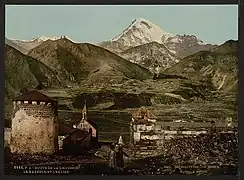 Construction of the Georgian Military Road through disputed territories was a key factor in the eventual Russian success
Construction of the Georgian Military Road through disputed territories was a key factor in the eventual Russian success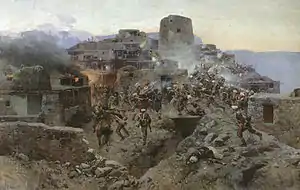 Assault of Gimry, by Franz Alekseyevich Roubaud
Assault of Gimry, by Franz Alekseyevich Roubaud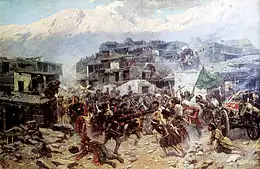 Caucasian tribesmen fight against the Cossacks, 1847
Caucasian tribesmen fight against the Cossacks, 1847 Storm of the fortress of Akhty in 1848
Storm of the fortress of Akhty in 1848 Circassians by Theodor Horschelt
Circassians by Theodor Horschelt.jpg.webp) Battle in the mountains, by Franz Roubaud, 1890.
Battle in the mountains, by Franz Roubaud, 1890. Mountaineers leave the aul, by Pyotr Gruzinsky
Mountaineers leave the aul, by Pyotr Gruzinsky Russian medal for subjugation of Western Caucasus 1859–1864
Russian medal for subjugation of Western Caucasus 1859–1864 Murid with the naib banner, by Theodor Horschelt 1858–1861.
Murid with the naib banner, by Theodor Horschelt 1858–1861.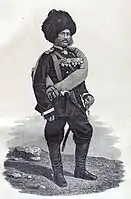 Officer of the Separate Caucasian сorps by A. L. Zisserman
Officer of the Separate Caucasian сorps by A. L. Zisserman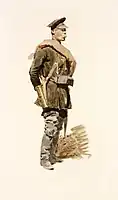 Artillery fireworker of the Separate Caucasian сorps
Artillery fireworker of the Separate Caucasian сorps Caucasian horseman warrior, by Oskar Schmerling 1893.
Caucasian horseman warrior, by Oskar Schmerling 1893.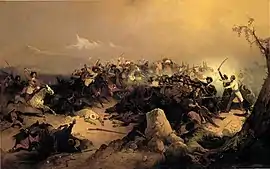 Fight with the сhechens under Akbulat-Urt, by D. Koenig (1849)
Fight with the сhechens under Akbulat-Urt, by D. Koenig (1849) Naibs of Imam Shamil, by Giorgio Corradini 19th century.
Naibs of Imam Shamil, by Giorgio Corradini 19th century. Circassian warrior, by Alfred Kowalski, 1895.
Circassian warrior, by Alfred Kowalski, 1895..jpg.webp) Caucasian rider in fight with Russian soldier, by Roubaud. F. (1892)
Caucasian rider in fight with Russian soldier, by Roubaud. F. (1892) Soldiers of the Shirvan regiment on Gunib, by Bogdan Willewalde (1870).
Soldiers of the Shirvan regiment on Gunib, by Bogdan Willewalde (1870).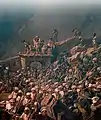 Assault of Gunib, by Pyotr Gruzinsky 1862.
Assault of Gunib, by Pyotr Gruzinsky 1862.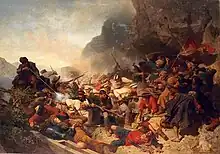 Battle of Ghunib, painting by Theodor Horschelt 1867.
Battle of Ghunib, painting by Theodor Horschelt 1867.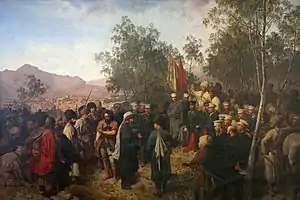 Capture of Shamil, painting by Theodor Horschelt 1859.
Capture of Shamil, painting by Theodor Horschelt 1859..png.webp) Shamil (front page). Illustrated London News of December 24, 1859.
Shamil (front page). Illustrated London News of December 24, 1859. Article of Illustrated London News about Russo-Circassian War.
Article of Illustrated London News about Russo-Circassian War.
See also
Notes
- ↑
- Бушуев 1941: "В организации борьбы за независимость ему приходилось по несколько раз принуждать одни и те же «вольные общества» Дагестана, а затем Чечни и Ингушетии, к борьбе против русского царизма."
- Тезисы докладов и сообщений 1989, p. 106: "Известно, что оформление военно-теократического государства по праву называемого имаматом Шамиля, и его расцвет пришлись на 1840—1850-е гг. В этот период в состав имамата входили практически весь Нагорный Дагестан, вся Чечня (за исключением междуречья Терека и Сужни), большая часть Карабулака («вилайет Арштхой»), ряд обществ Ингушетии («вилайет Калай»), некоторые аулы цоринцев и галгаевцев."
- Шамиль: Иллюстрированная энциклопедия 1997, p. 211: "Известно, что оформление военно-теократического государства по праву называемого имаматом Шамиля, и его расцвет пришлись на 1840—1850-е гг. В этот период в состав имамата входили практически весь Нагорный Дагестан, вся Чечня (за исключением междуречья Терека и Сужни), ряд обществ Ингушетии, некоторые аулы цоринцев и галгаевцев."
- Дадаев 2006, p. 223: "Пятый многолюдный съезд был созван 26 сентября 1841 г. в столице Имамата Дарго, где обсуждался вопрос о мерах борьбы с русским царизмом. Это было время, когда началась блистательная эпоха Шамиля, в состав Имамата вошли земли ликвидированного Аварского ханства, множество союзов сельских общин горного и предгорного Дагестана, почти вся Чечня, Ингушетия, отдельные аулы Хевсуретии и Тушетии."
References
- ↑ }}:
- ↑ Кроме того, командующему Отдельного Кавказского корпуса было подчинено Черноморское казачье войско — 40 тыс. чел.
- ↑ На Западном Кавказе
- 1 2 À la conquête du Caucase: epopée géopolitique et guerres d'influence
- ↑ "Victimario Histórico Militar".
- ↑ Richmond, Walter. The Circassian Genocide. ISBN 9780813560694.
- ↑ King, Charles (2008). The Ghost of Freedom: A History of the Caucasus. New York City, NY: Oxford University Press. ISBN 978-0-19-517775-6.
- ↑ Dowling, Timothy C., ed. (2014). Russia at War. Santa Barbara, California: ABC-CLIO. pp. 728–730.
In 1801, Russia annexed the Georgian Kingdom of Kartli–Kakheti.
- ↑ Robert F Baumann and Combat Studies Institute (U.S.), Russian-Soviet Unconventional Wars in the Caucasus, Central Asia, and Afghanistan (Fort Leavenworth, Kan: Combat Studies Institute, U.S. Army Command and General Staff College, n.d.)
- ↑ Yale University paper Archived December 29, 2009, at the Wayback Machine
- ↑ Bertolt Brecht The Caucasian Chalk Circle study guide http://www.gradesaver.com/the-caucasian-chalk-circle/study-guide/
- ↑ Jaimoukha, A., The Circassians: A Handbook, London: RoutledgeCurzon; New York; Routledge and Palgrave, 2001., page 63
- ↑ Richmond, Walter. The Circassian Genocide, Rutgers University Press, 2013., page 56
- ↑ Кабузан В.М. Население Северного Кавказа в XIX - XX веках. - СПб., 1996. С.145.
Bibliography
- Бушуев, С. (1941). "К биографии Шамиля" [To the biography of Shamil]. Красный архив (in Russian). Москва: ОГИЗ; Госполитиздат. 2 (102): 115–139.
- Дагестанский филиал АН СССР (1989). Народно-освободительное движение горцев Дагестана и Чечни в 20-50-х годах XIX в: Всесоюзная научная конференция, 20-22 июня 1989 г.: тезисы докладов и сообщений [The people's liberation movement of the highlanders of Dagestan and Chechnya in the 1820s–1850s: All-Union Scientific Conference, June 20–22, 1989: abstracts of reports and messages]. Makhachkala: Дагестанский филиал АН СССР. pp. 1–190.
- Казиев, Ш. М., ed. (1997). Шамиль: Иллюстрированная энциклопедия [Shamil: Illustrated Encyclopedia] (in Russian). Москва: Эхо Кавказа. pp. 1–220. ISBN 5-900054-01-2.
- Дадаев, Ю. У. (2006). Государство Шамиля: социально-экономическое положение, политико-правовая и военно-административная система управления [State of Shamil: socio-economic situation, political-legal and military-administrative system of government] (PDF) (in Russian). Махачкала: «Ихлас». pp. 1–491.
- Baddeley, John F. (1908). The Russian Conquest of the Caucasus. London: Longmans, Green and Co.
- Pokrovsky N. I. Caucasian Wars and the Imamate of Shamil / Foreword. N. N. Pokrovsky, introduction. and approx. V. G. Gadzhiev. — M.: ROSSPEN, 2000. — 511 p. — ISBN 5-8243-0078-X.
- Bell, J.S Journal of a residence in Circassia during the years 1837, 1838, and 1839 (English)
- Dubrovin, N. Russian: (Дубровин Н.Ф.) История войны и владычества русских на Кавказе, volumes 4–6. SPb, 1886–88.
- Kaziev, Shapi. Imam Shamil, Molodaya Gvardiya publishers: Moscow, 2001, 2003, 2006, 2010
- Kaziev, Shapi. Akhoulgo. Caucasian War of 19th century.
- The historical novel Epoch Publishing house. Makhachkala, 2008. ISBN 978-5-98390-047-9
- Gammer, Moshe. Muslim Resistance to the Tsar: Shamil and the Conquest of Chechnia and Daghestan. Frank Cass & Co. Ltd., 1994. 247 p. — ISBN 978-0714634319.
